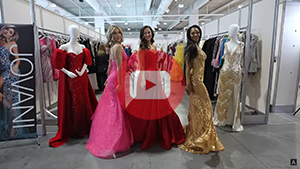ACTIVEWEAR TRENDS
SS25 Active: Regenerated!
As science, nature and tech combine to imagine a more sustainable future, a new version of modernity takes shape—a prospective way of life centered on well-being, innovation and, last but not least, mobility. Therefore, the categories that have organized our apparel consumption so far seem less and less relevant. More than inspiring each other, casualwear and sportswear more and more answer the same brief: functionality turned aesthetic, making active sportswear a laboratory for new ideas, materials, volumes and styles.
Life Is a (Tech) Trek
Like an open-air laboratory where science, nature and adventure meet, sportswear brands create a modular and functional wardrobe, both hybrid and designer, perfect for new conscious and committed adventurers. Technical materials like mesh and netting, paper-touch leather alternatives, or featherweight nylons offer a balance of functionality and aesthetics for a comfortable, nomadic lifestyle. Fabrics do not just support the performance but perform something themselves, as this vest (far left) designed by Finnish researchers from Aalto University, thanks to solar panels concealed in the fabric, harnesses the energy of the sun to power wearable devices and body sensors.
This bold, ongoing search for new materials has not only advantages in terms of functionality but also is the foundation for a new form of refinement—a sporty layering making the most of lightness and contrast. Because innovation makes it possible to combine breathability and thickness, ease of movement and the crispness of fabrics, constructed volumes and suppleness, it contributes to the gradual decompartmentalization of categories. Transparencies, fastening details, subtle shades, almost-tailored volumes become an integral part of the sports look. Sportswear is chic and for everyday, and practicing a sport becomes a holistic experience whose pleasantness starts with dressing and styling.
Sports accessories follow the same logic. More practical, benefiting from high-end innovations in terms of materials and production, they are also fashion accessories in their own right, to be used in the city as well as on the track. 3D printed shoes, crossover bags and rucksacks designed to hold in the lightest, easiest way everything that is needed on a trail or a to store one’s equipment, or sport caps easy to fasten and open and in breathable materials, are both an opportunity to perform better and to look more stylish. They also make total sense for a dressier occasion, becoming coveted fashion items, adding that little je ne sais quoi to the silhouette.
By Courtesy of Nature
Innovation and decompartmentalization are also reflected in new patterns, color palettes, and even textures and shapes, all inspired by nature. It’s an aesthetic that is less about realistically emulating nature than exploring an unusual, fantasized nature, seen through the lens of digital imagery. Think avatar more than English countryside. New camouflages between bio-mimicry and digital motifs, 3D effects and network prints, are an invitation to dive into a mysterious universe where patterns blend into an astonishing mix of seabed, space and nature. Accessories are the opportunity to be particularly daring and turn familiar objects into collectibles.
Another way nature makes its way into the active-sportswear wardrobe is through the way new designs are as much inspired by as stage the athletic body. From garments that accompany the body in its endeavors, sportswear pieces are inspired to showcase and enhance the body with complex cuts that encourage movement while emphasizing the harmony of shapes and muscles. Think sports-inspired lingerie for multiple uses and high-performance jerseys that emphasize their reinforced zones to make them patterns in themselves. The body is shown, literally and figuratively. Once again, sophistication and technicity are one.
Sports and nature used to have a strained relationship. On the one hand, sports seemed to be a lot about enjoying nature and paying tribute to it. On the other hand, technical materials often meant polluting materials. Good news is that the answer is to be found in nature itself. As does Pyratex Elements, textiles made from blends of fibers derived from agricultural waste such as orange peel and banana. Banana fiber is naturally absorbent, biodegradable and allergen-free, with a low overall impact on the environment, qualities that seduced womenswear brand Ganni for its sports line. And Pangaia partnered with textile brand Genometica to create high-performance clean jerseys.
Peclers Paris is a leading lifestyle trend-forecasting agency focused on building brands through the expertise of an international team of designers, strategic planners, futurists and consultants. The company has headquarters in Paris, Los Angeles and Shanghai






















